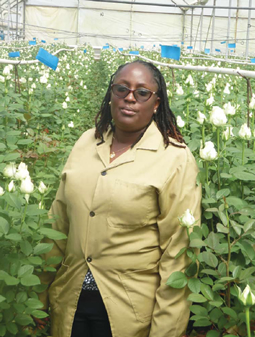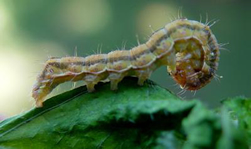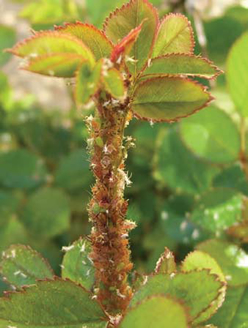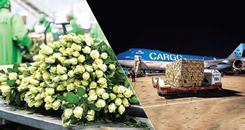Featured Past Articles
Switching to a different form of applied nitrogen could increase grower profits, improve plant physiology and raise plants’ stress tolerance, according to new research
By Adrian Bell
The alternative nitrogen – a chemically stabilised form of urea – would also optimise resource use while helping to reduce the environmental impact of fertiliser manufacture, according to British firm Levity Crop Science, which carried out the study on a range of containerised ornamentals.
“Plant development altered favourably and improved several commercial attributes, such as more branches and flowers, while raising tolerance to stress caused by drought or transplantation,” says David Marks, one of the study’s co-authors.
The findings, published in the Journal of Horticulture and Postharvest Research, suggest growers could make more efficient use of nitrogen fertiliser and produce healthier, more desirable plants by applying it in a more accessible form.
Growers preparing their thrips spray programs will have many options including Sivanto prime from Bayer CropScience and distributed by Elgon Kenya Ltd in the region. It was Pomp and dance as growers welcomed the latest insecticide from Bayer CropScience for the control of sucking insects. The new butenolide chemistry makes Sivanto Prime systemic insecticide that can be used to control wide range of sucking insects, such as aphids, whiteflies, thrips and other important pests.
 What is Sivanto Prime?
What is Sivanto Prime?
Sivanto Prime is the latest insecticide from Bayer Crop Science for the control of important sucking insects that fits perfectly in sustainable growing systems. Sivanto Prime protects your crop against a wide range of insects, such as whiteflies, aphids, and thrips and is effective against both nymphs / larvae and adult stages. Sivanto Prime has a fast activity and is absorbed by the leaf, after which the active substance moves in the direction of the juice flow. Also key, the mode of action of the active substance flupyradifurone, makes Sivanto Prime an asset in resistance management strategies.
What is the mechanism of action of Sivanto Prime?
Sivanto Prime works in the central nervous system of the insect as an agonist of the nicotinic acetylcholine receptor (nAChR) of the insect. The active substance flupyradifurone mimics the natural neurotransmitter. The long-lasting effect of the product results in a disorder of the nervous system of the insect,and subsequent death.
What makes Sivanto Prime unique?
Sivanto Prime has a very fast effective control against sucking insects and a favorable profile. Sivanto Prime gives effective vector control through fast activity and feeding ceasation in insects.
How is Sivanto Prime classified in the IRAC mode of action group? The Insecticide Resistance Action Committee (IRAC) has classified Sivanto Prime, (flupyradifurone), in the new subgroup 4D - Butenolides, a new subgroup of Group 4, which includes all insecticidal agonists of the nicotinic acetylcholine receptor (nAChR).
Concisely describe Christine Karambu
Christine is an agronomist and administrator with vast experience in the floriculture sector for over 18 years. The JKUAT graduate in horticulture who later on studied Business Administration, majoring in HR at KEMU holds several certifications gained during her professional path. She holds, among others FACTS; an international Fertilizer Recommendation course offered by BASIS and Women in Leadership by Strathmore University. Over the years, she has progressed through the ranks from a junior supervisor to her current level of senior management.
 What spurred you into growing? Any role model who inspired you?
What spurred you into growing? Any role model who inspired you?
In all honesty, I never thought this would be my career path. I grew up in a family that did large scale farming: my parents retired from their professions to exclusively focus on farming. I did not have interest then, until I joined high school and started feeling the touch. My interest grew as I watched my parents address and train students from colleges and other institutions of higher learning. Through the results of my hard work, as well as the multiple challenges I faced on my journey, my inspiration grew exponentially, to the point where I firmly knew my interest lay in the industry.
Kindly take us through your journey as a grower to your current position.
I have been in the floriculture sector for a total of 18 years. As you can see, I’m no spring chicken in the field. After college, I began my journey in (the former) Kijabe Limited as a supervisor and then joined 3 other companies as I rose through the ranks. I’m presently at the Oserian Development Company, as a senior grower, and I’ve been here for the last four years and counting. In addition to this, I over-see the company’s Research and Development unit.
Briefly discuss the challenges you go through daily? What would you point out as your strongest attribute that has made you succeed? How do you rise up to the greatest challenge that your job presents?
Growing presents different challenges every day: the weather patterns are unpredictable, pests and diseases are always piling on pressure and the market trends are typically volatile. Early on, I struggled with numerous, varied challenges. I’ll admit to that much. But rather than get cowed and give up, I chose to adapt and grow. This helped me internalize one of my most valuable lessons: every challenge has a solution; you just have to think outside the box sometimes. I have learned the value of self-motivation, constant research to stay ahead, lots of consultation and taking one day at a time. I have learned that each day, at the very least, presents a learning opportunity or two. My job also requires that I motivate others; I really have no window for dullness or giving up. For the sake of my staff and the projects I am at the helm of, I have to be perpetually motivated. To lead properly, I have to actually listen, as opposed to just hearing things.
Helicoverpa Armigera (African Bollworm) Caterpillars in Flowers
 Caterpillars are seasonal pests to the flowers but when in season result in major losses to the flower industry as one caterpillar can cause damage to more than one flower. In flowers there are different kinds of caterpillar species which include helicoverpa armigera and spodopteraexigua and thus it’s important to know the exact pest that one has in their crop and out of these two, the helicoverpa species is the notorious and listed as a notifiable pest in the European market.
Caterpillars are seasonal pests to the flowers but when in season result in major losses to the flower industry as one caterpillar can cause damage to more than one flower. In flowers there are different kinds of caterpillar species which include helicoverpa armigera and spodopteraexigua and thus it’s important to know the exact pest that one has in their crop and out of these two, the helicoverpa species is the notorious and listed as a notifiable pest in the European market.
Description
Helicoverpa armigera commonly known as African bollworm is the main caterpillar that infests flowers in green houses and outdoor ones. It is a pest of roses, carnations, hypericum, gypsophilla amongst other flowers. It is a moth with the larval stages referred to as caterpillar being the destructive stage. It is unique in that the moth lays its eggs singly on the roses and specifically on the softest parts of the crop. In roses the eggs are found on the flower buds and petals. The eggs are small, yellowish-white, ribbed and rather dome shaped. The egg period is two days after which it hatches to a larva- the caterpillar. The caterpillar eats the eggshell to emerge after which it bolls making circular holes through the petals only to feed from inside the flower. The color of the African bollworm caterpillar varies from green to reddish brown; has three dark stripes that extend along the dorsal side and one yellow light stripe situated under the spiracles on the lateral side. When the caterpillar is disturbed, it lifts its head and curls it under the front of the body. If even more disturbed, it lets go and drops, rolling into a spiral. There are 6 instars or stages of the caterpillar in a larval period of 16 days and the damage to the crop increases with increase in size of the caterpillar. These caterpillars are cannibalistic. When a caterpillar matures it drops into the soil or the growth media to pupate. The pupa is shiny brown; about 16mm long with smooth surface and with two short parallel spines at the posterior tip of the body and the pupal period is 10 days at normal temperatures. The pupa is dormant and doesn’t feed.
Due to its varied climatic and ecological zones, Kenya provides a suitable environment for growing vegetables for export. The country has a well-qualified and experienced agricultural labour force, and its location and well-developed connectivity with key markets are key elements in the growing of fresh produce exports, writes Mr. David Mulandi of Amiran Kenya Ltd.
 Kenyan vegetable growers are organized into either large group farms, single farms or out growers who produce for export companies under contract. The latter have to follow rules put in place by the contacting company. This is to ensure that homogeneity and food safety standards are met to the satisfaction of the produce’s end user.
Kenyan vegetable growers are organized into either large group farms, single farms or out growers who produce for export companies under contract. The latter have to follow rules put in place by the contacting company. This is to ensure that homogeneity and food safety standards are met to the satisfaction of the produce’s end user.
All Kenyan produce for export are produced under strict adherence to Global GAP stipulations, which dictate on the requirements being met before anyone is allowed to export vegetables. Sufficient measures are put in place to ensure that sanitary and phytosanitary basics are considered by all growers.
Several government institutions are tasked with the certification and inspection of the Kenyan produce, which has led to steady growth in both export value and volume.
Economic importance of Export Vegetables in Kenya
Kenya is one of the key exporters of fresh vegetables to the European Union with over 87,000 tons per year. These exports are valued at more than 24 billion Kenya shillings.
Besides earning the country revenue through exports the vegetables segment contributes enormously in jobs creation for Kenyans and expatriates working in the industry. Thousands of Kenyans earn a living either directly or indirectly by working in or with the vegetable growing farms.
 After climbing one great hill, one only realizes that there are many more mountains to climb’. This old adage attributed to one of African greats rings true in thrips management.
After climbing one great hill, one only realizes that there are many more mountains to climb’. This old adage attributed to one of African greats rings true in thrips management.
The recent restrictions of numerous active ingredients especially from organophosphates and neonicotinoids classes by different markets has made management of thrips very difficult as our senior correspondent found out. Growers serving different markets are in a dilemma and a cross check of their stores one will mistake them to a stockist. Some markets will restrict acephates others will accept, some imidacloprid others not, it is the same story with abamactin, thiamethoxam, thiacloprid, carbamates, fipronil, mancozeb etc.
As this is happening Kenya is facing acute water challenge and thrips been hydrophobic are multiping very fast. The past few years has seen the rise and spread of thrips in greenhouse farming, hitherto a minor pest, to become the most destructive insect pests of the greenhouses. Thrips are hitting growers where it hurts most!
Thrips has been, and still is, a difficult insect pest to control or regulate in greenhouse production systems leading many to believe that we have reached an impasse regarding its management. Dealing with thrips, therefore, requires a holistic approach integrating the methods detailed above. Key in this approach is knowledge about the biology of the pest, and indeed all other relevant pests, the crop (s), the cropping systems, pest management options etc. Knowledge, we believe is the best weapon against pests!
What are thrips?
Thrips are minute, slender insects, usually only a few millimetres long with piercing-sucking-mouthparts and the ability to cause direct damage to flowers making it unmarketable for export.
How do thrips feed?
Thrips have piercing-sucking mouthparts. They use a needle-like structure to puncture plant tissue and a second tube-like structure which is placed into the hole through which plantsap is extracted, subsequently causing direct damage to the crop.
 Regardless of how you grow, the profitability of your farm will depend on three main factors: demand, viability, and profit margin. Lots of new farmers focus the majority of their efforts on their ability to grow a single crop and forget to do research on the other factors.
Regardless of how you grow, the profitability of your farm will depend on three main factors: demand, viability, and profit margin. Lots of new farmers focus the majority of their efforts on their ability to grow a single crop and forget to do research on the other factors.
Turkish Cargo carries 4k tonnes flowers from Nairobi, Quito
Turkish Cargo transported 4,000 tonnes of flowers from Nairobi, Kenya to Stansted, Narita, Maastricht, and Riyadh; and from Quito, Ecuador to Amsterdam, Beijing, Manila, Jakarta and Taiwan, in addition to its charter flights.
The accomplished air cargo brand carried flowers between January 1 to February 10, 2019. Providing its services by means of the airconditioned aircraft for maximum freshness and shelf-life with cold chain solutions, Turkish Cargo makes it possible to carry the flowers of Africa, an important centre to grow flowers, to the entire world with its air cargo services provided to 36 countries across the African region, and a total of 54 destinations.


